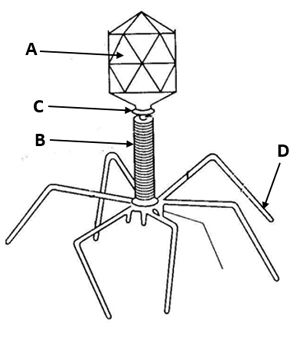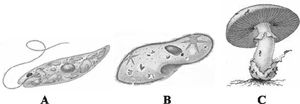Match the scientists given in column I with their discovery given in column II and choose the correct option.
| Column-I | Column-II |
|---|---|
| (Scientists) | (Discovery) |
| A. Ernst Mayr | I. Discovered Viroids |
| B. Whittaker | II. Gave the name virus |
| C. Pasteur | III. Proposed five kingdom classification |
| D. Diener | IV. Darwin of the 20th century |
A IV, B III, C II, D I
A III, B IV, C II, D I
A II, B III, C IV, D I
A I, B II, C III, D IV
Correct Answer :
A. A IV, B III, C II, D I
Ernst Mayr was a renowned taxonomist, tropical explorer, ornithologist, and historian of science. His work contributed to the conceptual revolution that led to the modern evolutionary synthesis of Mendelian genetics, systematics, and Darwinian evolution, and to the development of the biological species concept. Robert Harding Whittaker was a distinguished American plant ecologist. He was the first to propose the five-kingdom taxonomic classification of the world's biota into the Animalia, Plantae, Fungi, Protista, and Monera in 1959. Louis Pasteur was a French chemist and microbiologist renowned for his discoveries of the principles of vaccination, microbial fermentation and pasteurization. He gave the name virus. Theodor Otto Diener discovered the viroid, a plant pathogen one fiftieth of the size of the smallest viruses. These tiny single-stranded RNA molecules were responsible for causing a devastating disease of potato plants, called potato spindle tuber disease, as well as at least 15 other crop diseases. Diener named it the viroid because it is like a virus.
Related Questions
Match the characters given in column I with their examples given in column II.
| Column I | Column II |
|---|---|
| A. Long slender thread | (i) Lichen like structures |
| B. Association of fungi with | (ii) Mycorrhiza roots of higher plants |
| C. Parasitic fungi on mustard | (iii) Neurospora |
| D. Fungi extensively used in | (iv) Albugo biochemical and genetic work |
| E. An association in which | (v) Hyphae algal component is called phycobiont |
A-(v) B-(ii) C-(iv) D-(iii) E-(i)
A-(iii) B-(i) C-(iv) D-(ii) E-(v)
A-(ii) B-(i) C-(iii) D-(v) E-(iv)
A-(iii) B-(ii) C-(iv) D-(i) E-(v)
Which of the following is used extensively in biochemical and genetic work ?
Agaricus
Alternaria
Neurospora
Mucor
Which of the following statement is correct for dinoflagellates flagella ?
A single flagellum lies in the transverse groove between the cell plates.
A single flagellum lies in the longitudinal groove between the cell plates.
Two flagella, one lies longitudinally and the other transversely in a furrow between the wall plates.
Flagella are absent.
A specimen of fungus is brought by a student for identification. Upon close examination, he discovered that its hyphae are completely septate and it has gills on the underside of the pileus. To which fungal group does it most likely belong ?
Basidiomycetes
Zygomycetes
Ascomycetes
Chytrids
The genetic material of virus includes
only RNA.
only DNA.
RNA and DNA both
RNA or DNA i.e. one nucleic acid in a virus.
Which of the following groups of protozoan is not correctly matched with its feature?
Amoeboid - Marine forms have silica shells on their surface.
Flagellated - Either free living or parasitic.
Ciliated - Actively moving organisms due to presence of cilia.
Sporozoans - Move and capture their prey with the help of false feet.
Which of the following pairs comes under the group chrysophytes ?
Diatoms and Euglena
Euglena and Trypanosoma
Diatoms and Desmids
Gonyaulax and Desmids
Which one single organism or the pair of organisms is correctly assigned to its taxonomic group?
Paramecium and Plasmodium belong to the same kingdom as that of Penicillium.
Lichen is a composite organism formed from the symbiotic association of an alga and a protozoan.
Yeast used in making bread and beer is a fungus.
Nostoc and Anabaena are examples of protista.
Match the type of protozoans given in column-I with their examples given in column-II and choose the correct option.
| Column-I | Column-II |
|---|---|
| (Type of Protozoans) | (Examples) |
| A. Amoeboid protozoans | I. Paramecium |
| B. Ciliated protozoans | II. Plasmodium |
| C. Flagellated protozoans | III. Amoeba |
| D. Sporozoans | IV. Trypanosoma |
A I; B III; C IV; D II
A III; B I; C II; D IV
A III; B I; C IV; D II
A III; B IV; C I; D II
Which of the following statement(s) is/are correct about ascomycetes ?
(i) Neurospora, which is used in biochemical and genetic work is a member of this class.
(ii) They are mostly multicellular, e.g., Yeast, or rarely unicellular, e.g., Penicillium.
(iii) They are saprophytic, decomposers, parasitic or coprophilous.
(iv) Some examples are Aspergillus, Claviceps and Neurospora.
Both (i) and (ii)
Only (ii)
(i), (iii) and (iv)
All of these
Which of the following is smallest living cell and can live without oxygen ?
Mycoplasma
Mycorrhiza
Euglena
Trypanosoma
The most abundant prokaryotes helpful to humans in making curd from milk and in production of antibiotics are the ones categorised as
cyanobacteria
archaebacteria
chemosynthetic autotrophs
heterotrophic bacteria
The given characters are seen in which of the following group?
(i) Unicellular, colonial, filamentous, marine or terrestrial forms.
(ii) The colonies are surrounded by a gelatinous sheath.
(iii) Some can fix atmospheric nitrogen in specialized cells called heterocysts.
(iv) They often form blooms in water bodies.
Archaebacteria
Cyanobacteria
Chrysophytes
Dinoflagellates
Which of the following pair is not correctly matched ?
Anabaena Cyanobacteria
Amoeba Protozoa
Gonyaulax Dinoflagellates
Albugo Chrysophytes
Read the following statements and answer the question.
(i) Some members are saprophytes or parasites while a large number of them are decomposers of litter and help in mineral cycling.
(ii) They reproduce only by asexual spores known as conidia.
(iii) Mycelium is septate and branched.
(iv) Alternaria, Colletotrichum and Trichoderma are examples of this class.
Which of the following class of fungi is being described by the above statements ?
Phycomycetes
Deuteromycetes
Basidiomycetes
Ascomycetes
Match column I (Kingdom) with column II (Class) and select the correct options
| Column-I | Column-II |
|---|---|
| (Kingdom) | (Class) |
| A. Plantae | I. Archaebacteria |
| B. Fungi | II. Euglenoids |
| C. Protista | III. Phycomycetes |
| D. Monera | IV. Algae |
A IV, B III, C II, D I
A I, B II, C III, D IV
A III, B IV, C II, D I
A IV, B II, C III, D I
Which of the following class of fungi is being described by the given statements ?
(i) They are found in aquatic habitats and on decaying wood in moist and damp places.
(ii) Mycelium is aseptate and coenocytic.
(iii) Asexual reproduction takes place by zoospores (motile) or by aplanospores (non-motile).
(iv) Some common examples are Mucor, Rhizopus and Albugo.
Ascomycetes
Phycomycetes
Basidiomycetes
Deuteromycetes
Which of the following statements regarding cyanobacteria is incorrect?
It is also called blue green algae.
They are chemosynthetic autotrophs.
It forms blooms in polluted water bodies.
It is unicellular, colonial or filamentous, marine or terrestrial bacteria.
Lichens indicate SO2 pollution because they
show association between algae and fungi.
grow faster than others.
are sensitive to SO2.
flourish in SO2 rich environment.
The figure given below shows the structure of a bacteriophage. Identify its parts labelled as A, B, C and D.

A - Tail fibres B - Head C - Sheath D - Collar
A - Sheath B - Collar C - Head D - Tail fibres
A - Head B - Sheath C - Collar D - Tail fibres
A - Collar B - Tail fibres C - Head D - Sheath
Which of the following statement is/ are correct for bacteria ?
They are the members of the kingdom monera.
They live in extreme habitats such as hot springs, deserts, snow and deep oceans.
They show the most extensive metabolic diversity.
All of the above
Which of the following statement(s) is/are correct about class basidiomycetes ?
(i) They are commonly known as imperfect fungi because only the asexual or vegetative phases of these fungi are known.
(ii) They grow in soil, on logs and tree stumps and in living plant bodies as parasites, e.g., rusts and smuts.
(iii) The mycelium is branched and septate.
(iv) Some common members are Agaricus, Ustilago and Puccinia.
Only (i)
Both (ii) and (iii)
(ii), (iii) and (iv)
All of these
Which one of the following is a characteristic feature of chrysophytes?
They are parasitic forms which cause diseases in animals.
They have a protein rich layer called pellicle.
They have indestructible wall layer deposited with silica.
They are commonly called dinoflagellates.
Bacteria are found to be primitive organisms because they
are small, microscopic which are not seen with naked eye.
cause serious diseases to human being, domesticated animals and crop plants.
produce endospores which are very resistant to adverse conditions.
possess incipient nucleus and show amitotic division.
Which of the following statement(s) is/are correct ?
(i) Reproduction in fungi can take place by vegetative means fragmentation, fission and budding.
(ii) Fusion of two nuclei is called plasmogamy.
(iii) Fusion of protoplasms between two motile or nonmotile gametes is called karyogamy.
(iv) Meiosis in zygote results in diploid spores.
Only (i)
Both (ii) and (iii)
(ii), (iii) and (iv)
All of these
The bacteria which oxidize various inorganic substances and use the released energy for their ATP production are called _______________.
Archaebacteria
Heterotrophic bacteria
Photosynthetic autotrophic bacteria
Chemosynthetic autotrophic bacteria
Identify the following figures A, B and C.

A – Euglena, B – Paramecium, C – Agaricus
A – Euglena, B – Planaria, C – Agaricus
A – Planaria, B – Paramecium, C – Agaricus
A – Euglena, B – Paramecium, C – Aspergillus
T. O. Diener discovered a new infectious agent that was smaller than viruses and have the following characteristics.
(i) It causes potato spindle tuber disease.
(ii) It has free RNA.
(iii) Molecular weight of RNA is low.
Identify the infections agent.
Viruses
Viroids
Virion
Mycoplasma
Which of the following is not a viral disease ?
AIDS and mumps
Small pox and herpes
Influenza
Cholera
Match column I with column II and choose the correct option.
| Column I | Column II |
|---|---|
| A. Mycoplasma | (i) Nitrogen fixing cells |
| B. Decomposers | (ii) Blue green algae |
| C. Methanogens | (iii) Production of methane |
| D. Heterocysts | (iv) Most abundant heterotrophs |
| E. Cyanobacteria | (v) Pathogenic in plants and animals |
A-(i) B-(ii) C-(iii) D-(iv) E-(v)
A-(iii) B-(v) C-(ii) D-(iv) E-(i)
A-(iii) B-(i) C-(v) D-(ii) E-(iv)
A-(v) B-(iv) C-(iii) D-(i) E-(ii)
